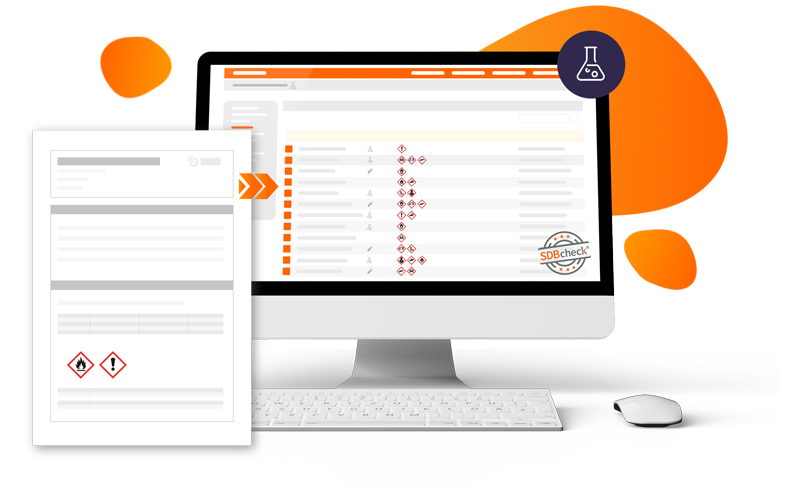
Chemical products and hazardous substances must be labeled according to clear regulations – this is stipulated by the CLP Regulation , among others [1] stipulates. The so-called H-phrases are a central component of this labeling. These standardized hazard statements describe the risks posed by a substance or mixture – for example, fire hazard, health hazard or environmental hazard.
The H-phrases consist of a code (e.g. H225 or H315) and a corresponding statement such as “Highly flammable liquid and vapor” or “Causes skin irritation”. They are therefore an important element in correctly understanding and applying the hazards in everyday working life.
What exactly are H-phrases?
H-phrases – also known as hazard statements – are internationally standardized formulations for describing hazards. They are part of the mandatory labeling of hazardous substances and mixtures and can be found on:
✔ Product labels
✔ Safety data sheets (sections 2 and 16)
✔ Operating instructions
✔ and in the list of hazardous substances
Every substance that is classified as hazardous must be labeled with at least one appropriate H-phrase.
What do the H-phrases stand for?
The combination of letters and numbers (e.g. H302) is no coincidence. The H-phrases are divided into three main groups:
H2xx – physical hazards (e.g. explosion hazard)
H3xx – Health hazards (e.g. acute toxicity, skin irritation)
H4xx – Environmental hazards (e.g. hazards to the aquatic environment)
This structure facilitates classification and helps to derive suitable protective measures.
Why are H-phrases important in everyday working life?
H-phrases are not only mandatory information – they also actively support occupational safety. They help with this:
- Recognize risks quickly
- Making workplaces safe
- Provide employees with targeted instruction
- comply with legal requirements in hazardous substance management
In combination with GHS pictograms and P-phrases (precautionary statements), H-phrases enable transparent and comprehensible communication of chemical hazards.
Note on use on your website or in operating instructions
Ensure that the H-phrases are used correctly and in full. Abbreviated or inaccurate formulations can lead to misunderstandings – especially during training, label printing or audits. Ideally, use official sources or automated solutions such as SDBcheck® for reliable and correct documentation.
All H-phrases at a glance

Physical hazards
| H200 | Unstable, explosive. |
| H201 | Explosive, danger of mass explosion. |
| H202 | Explosive; great danger from splinters, explosives and thrown objects. |
| H203 | Explosive; danger from fire, air pressure or splinters, blasting and throwing fragments. |
| H204 | Danger from fire or splinters, explosives and thrown objects. |
| H205 | Risk of mass explosion in case of fire. |
| H206 | Danger from fire, blast or explosives; increased risk of explosion if the desensitizing agent is reduced. |
| H207 | Danger from fire or explosives; increased risk of explosion if the desensitizing agent is reduced. |
| H208 | Fire hazard; increased risk of explosion if the desensitizing agent is reduced. |
| H220 | Extremely flammable gas. |
| H221 | Flammable gas. |
| H222 | Extremely flammable aerosol. |
| H223 | Flammable aerosol. |
| H224 | Extremely flammable liquid and vapor. |
| H225 | Highly flammable liquid and vapor. |
| H226 | Flammable liquid and vapor. |
| H228 | Flammable solid. |
| H229 | Pressurized container: may burst when heated. |
| H230 | Can also react explosively in the absence of air. |
| H231 | May also react explosively in the absence of air at elevated pressure and/or temperature. |
| H232 | May ignite spontaneously on contact with air. |
| H240 | Heating may cause an explosion. |
| H241 | Heating may cause fire or explosion. |
| H242 | Heating can cause fire. |
| H250 | Ignites spontaneously in contact with air. |
| H251 | Self-heating; can catch fire. |
| H252 | Self-heating in large quantities; may catch fire. |
| H260 | In contact with water, flammable gases are produced which can ignite spontaneously. |
| H261 | Flammable gases are produced in contact with water. |
| H270 | May cause or intensify fire; oxidizing agent. |
| H271 | May cause fire or explosion; strong oxidizer. |
| H272 | May intensify fire; oxidizing agent. |
| H280 | Contains gas under pressure; may explode if heated. |
| H281 | Contains refrigerated gas; may cause cold burns or injuries. |
| H290 | May be corrosive to metals. |

Health hazards
| H300 | Danger to life if swallowed. |
| H301 | Toxic if swallowed. |
| H302 | Harmful if swallowed. |
| H304 | May be fatal if swallowed and enters the respiratory tract. |
| H310 | Danger to life in case of skin contact. |
| H311 | Toxic in contact with skin. |
| H312 | Harmful in contact with skin. |
| H314 | Causes severe skin burns and eye damage. |
| H315 | Causes skin irritation. |
| H317 | May cause allergic skin reactions. |
| H318 | Causes serious eye damage. |
| H319 | Causes serious eye irritation. |
| H330 | Danger to life if inhaled. |
| H331 | Toxic by inhalation. |
| H332 | Harmful if inhaled. |
| H334 | May cause allergy or asthma symptoms or breathing difficulties if inhaled. |
| H335 | May irritate the respiratory tract. |
| H336 | May cause drowsiness and dizziness. |
| H340 | May cause genetic defects (specify route of exposure if there is conclusive evidence that no other route of exposure poses this risk). |
| H341 | Suspected of causing genetic defects (state route of exposure if there is conclusive evidence that no other routes of exposure cause this hazard). |
| H350 | May cause cancer (specify route of exposure if there is conclusive evidence that no other routes of exposure cause this hazard). |
| H350i | May cause cancer if inhaled. |
| H351 | Suspected of causing cancer (state route of exposure if there is conclusive evidence that no other routes of exposure cause this hazard). |
| H360 | May damage fertility or the unborn child if known, state specific effect Specify route of exposure if there is conclusive evidence that no other routes of exposure cause the hazard. |
| H360D | May cause harm to the unborn child. |
| H360F | May impair fertility. |
| H360FD | May impair fertility. May harm the unborn child. |
| H360Df | May cause harm to the unborn child. May presumably impair fertility. |
| H360Fd | May impair fertility. May probably harm the unborn child. |
| H361 | Suspected of damaging fertility or the unborn child , if known, state specific effect Specify route of exposure if there is conclusive evidence that no other routes of exposure cause the hazard. |
| H361d | Can probably harm the child in the womb. |
| H361f | May presumably impair fertility. |
| H361fd | May presumably impair fertility. Suspected of damaging the unborn child. |
| H362 | May harm infants through breast milk. |
| H370 | Causes damage to organs or all organs affected, if known Indicate route of exposure if there is conclusive evidence that no other routes of exposure cause the hazard. |
| H371 | May cause damage to organs or name all organs affected, if known Indicate route of exposure if there is conclusive evidence that no other routes of exposure cause the hazard. |
| H372 | Causes damage to organs all organs affected state route of exposure for prolonged or repeated exposure if there is conclusive evidence that no other route of exposure presents this hazard. |
| H373 | May cause damage to organs state all organs affected in case of prolonged or repeated exposure state route of exposure if there is conclusive evidence that no other routes of exposure cause the hazard. |
| H373 | May cause damage to organs state all organs affected in case of prolonged or repeated exposure state route of exposure if there is conclusive evidence that no other routes of exposure cause the hazard. |
| H300 + H310 | Danger to life if swallowed or in contact with skin |
| H300 + H330 | Danger to life if swallowed or inhaled |
| H310 + H330 | Danger to life in case of skin contact or inhalation |
| H300 + H310 + H330 | Danger to life if swallowed, in contact with skin or inhaled |
| H301 + H311 | Toxic if swallowed or in contact with skin |
| H301 + H331 | Toxic if swallowed or inhaled |
| H311 + H331 | Toxic by skin contact or inhalation |
| H301 + H311 + H331 | Toxic if swallowed, in contact with skin or if inhaled |
| H302 + H312 | Harmful if swallowed or in contact with skin |
| H302 + H332 | Harmful if swallowed or inhaled |
| H312 + H332 | Harmful in contact with skin or if inhaled |
| H302 + H312 + H332 | Harmful if swallowed, in contact with skin or if inhaled |

Environmental hazards
| H400 | Very toxic to aquatic organisms. |
| H410 | Very toxic to aquatic organisms, with long lasting effects. |
| H411 | Toxic to aquatic organisms, with long lasting effects. |
| H412 | Harmful to aquatic organisms, with long lasting effects. |
| H413 | May be harmful to aquatic organisms with long lasting effects. |
| H420 | Harms public health and the environment through ozone depletion in the outer atmosphere. |
Using H-phrases correctly – that’s what matters
Simply knowing the H-phrases is a first step – but their correct application in day-to-day operations is crucial. Because only those who interpret the hazard statements correctly can take targeted action, minimize risks and protect employees effectively.
To achieve this, H-phrases should always be used in conjunction with the appropriate GHS pictograms, P-phrases and information from the safety data sheet. Complete and up-to-date documentation in the hazardous substances register is essential – especially for audits or as part of the duty to instruct.
Professional references & references
[1]
Act now: Digital hazardous substance management with SDBcheck®
A legally compliant hazardous substance management does not have to be complicated or time-consuming. SDBcheck® helps you to implement all GHS requirements efficiently:
✔ Manage hazardous substances digitally – put an end to confusing Excel lists
✔ Safety data sheets always to hand – automatic updates and structured filing
✔ Meet legal requirements – ISO 14001 and 9001 compliant hazardous substances register easy to manage
✔ Protection for your team – keep employees informed at all times and ensure safety
➜ Use SDBcheck® now for simple, digital hazardous substance management!
Visit our webinar

Are you responsible for managing hazardous substances and struggling with confusing Excel lists? Are you missing a simple, digital solution to efficiently maintain your hazardous substances register and keep it up to date?
What you can expect:
✔ Legal basics explained clearly – what is really important
✔ Automated reading of safety data sheets – save time instead of typing
✔ Why a software solution is superior to Excel – efficiency, safety & transparency ✔ Step-by-step to digital hazardous substance management – from recording to release ✔ Simple updating & management – always up to date Transparency
✔ Step-by-step to digital hazardous substance management – from recording to release
✔ Easy updating & management – always up to date
✔ Safe release of hazardous substance information for employees – targeted & structured











